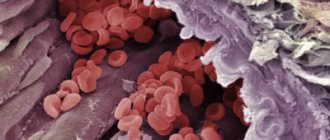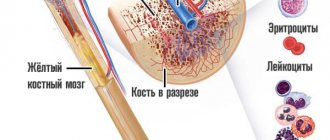- What function do lymphocytes perform?
- Types of lymphocytosis
- Physiological lymphocytosis
- Lymphocytosis in viral diseases
- Lymphocytosis in bacterial infections
- Hematological diseases
- Endocrine system diseases
- Rheumatological, allergic and parasitic diseases
- Diagnosis of lymphocytosis
- Treatment of lymphocytosis
Lymphocytosis is a type of leukocytosis.
This is a condition in which the level of lymphocytes in the blood of an adult exceeds 4000 units, and in children under 5 years of age - 6000 units per microliter. In percentage terms, this ranges from 40% or more for adults and 55% for young children. Normally, the blood of a healthy adult contains 20-40% lymphocytes. Lymphocytosis can occur for physiological and pathological reasons. As a rule, in most cases it is one of the symptoms of the disease. The cause of lymphocytosis can be not only blood diseases, but also viruses, infections, and certain physiological reactions.
To diagnose lymphocytosis, venous or capillary blood is used. Laboratory testing determines the main blood parameters, including the level of lymphocytes.
What function do lymphocytes perform?
These blood cells provide the body's defense against pathogens. Lymphocytes produce immunoglobulins - antibodies that bind to viral infection and thereby prevent it from entering the cells of organs and tissues. Lymphocytes are also part of the mechanism to destroy cells that are already infected with the virus. In a similar way, lymphocytes can fight certain types of bacterial and parasitic infections. Thus, an increase in lymphocytes in the blood is the response of the immune system when an infection enters the body.
Causes of development of chronic lymphocytic leukemia
Possible etiological factors for the development of chronic lymphocytic leukemia include:
- chromosomal mutations
- hereditary predisposition
- viral infections
According to a number of scientists, long-term stimulation of the human immune system (for example, during frequent infections) can lead to genetic damage and tumor degeneration of lymphocytes, the formation of a clone of leukemic cells and the occurrence of CLL.
A direct causal relationship between exposure to carcinogens and ionizing radiation and the occurrence of CLL has not been established.
The mechanism of development of chronic lymphocytic leukemia is the transformation of lymphocytes into tumor cells and their proliferation, which leads to inhibition of normal hematopoiesis, the development of anemia and thrombocytopenia.
Types of lymphocytosis
The disease is divided into relative and absolute types. Relative is characterized by an increase in the number of lymphocytes against the background of normal or reduced levels of leukocytes in the blood.
With absolute lymphocytosis, the level of lymphocytes is exceeded, as is the content of leukocytes.
According to the degree of excess, moderate and high lymphocytosis are distinguished. If the percentage of lymphocytes is below 60%, we are talking about moderate lymphocytosis. When the lymphocyte content is high, it is above 60%, which may be a sign of a malignant hematological disease or diseases of the lymphatic system.
Physiological lymphocytosis
Sometimes an increase in lymphocytes is not associated with a disease and is a natural reaction of the body. The main reasons for this phenomenon are:
- early childhood;
- psycho-emotional stress;
- fasting, avoidance of animal products;
- taking certain medications.
In children under 4-5 years of age, an increased level of lymphocytes is a physiological norm. Already from the first week of life in a newborn, the lymphocyte count reaches 55-60%. This is due to age-related characteristics of the immune system. By 4-5 years, the level of lymphocytes decreases to 40%. If in a small child this figure exceeds 60%, this is a pathology.
As for lymphocytosis during stress, fasting, and taking medications, the change in the leukocyte formula is short-term. The indicators return to normal as soon as the causative factor ceases to affect the body.
Classification of leukocytosis
A shift in leukocytosis does not always indicate a disease. According to biological characteristics, two types are distinguished:
- physiological leukocytosis;
- pathological increase in leukocytosis.
The physiological type is the norm of leukocytosis. It occurs in absolutely everyone and does not pose any danger. In certain circumstances, even a healthy person has moments in everyday life when an increase in white blood cells occurs. Factors influencing this physiological process may be different. For example, there is the concept of food reactive leukocytosis. As a rule, it occurs 2-3 hours after eating. Another common factor is playing sports or other intense physical activity. As a result of muscle work, the level of leukocytes temporarily increases. The physiological type of leukocytosis in women during pregnancy is a completely normal phenomenon during the second trimester of pregnancy.
Pathological leukocytosis in the blood develops against the background of diseases, therefore, correction of the level of leukocytes is carried out by treating the disease against which it developed.
The following types of leukocytosis are distinguished.
Depending on the degree of increase in the level of leukocytes:
- moderate leukocytosis - an increase in the level from normal to 15,000;
- high leukocytosis – level range from 15,000 to 50,000;
- hyperleukocytosis - the concentration level exceeds 50,000. This degree of the disease is characterized by the presence of a large number of unformed white cells;
By type of leukocytes that exceeded the norm:
- neutrophilic or neutrophilia. The excess of neutrophils is more than 75%. Changes can be provoked by suppurative processes, as well as various bacterial infections;
- lymphocytic or lymphocytosis. The level of lymphocytes exceeds 38% in adults (for children under 7 years of age, this figure is 55%). The cause may be lymphoproliferative diseases, as well as viral infections;
- monocytic or monocytosis. The level of monocytes exceeds 10%. Common causes include septic endocarditis, granulomatous processes, protozoal infections;
- eosinophilic or eosinophilia. Exceeding the norm is more than 5%. The cause may be allergic reactions, a number of lung diseases, helminthic infestations, etc.;
- basophilic or basophilia. Basophil level more than 1%. This shift in leukocytosis is very rare. Among the causes, experts identify nonspecific ulcerative colitis, polycythemia vera, and allergies.
Lymphocytosis in viral diseases
Diseases caused by viruses are a common cause of lymphocytosis. In adults, it occurs with influenza and acute respiratory infections. In children - with chickenpox, measles, rubella. As a rule, patients are diagnosed with moderate lymphocytosis, which occurs as the symptoms of the disease increase. After recovery, blood counts return to normal.
The exception is infectious mononucleosis caused by the Epstein-Barr virus. The pathogen belongs to the herpevirus family. It multiplies in B lymphocytes and stimulates their growth. Adults and children are susceptible to this disease, but in childhood the risk of getting sick is much higher. In middle-aged and mature people, the pathology occurs without pronounced symptoms, since specific immunity has already been formed.
Against the background of infectious mononucleosis, persistent moderate lymphocytosis is observed. In addition, atypical mononuclear cells are found in the blood - large cells characteristic of the disease.
Lymphocytosis in bacterial infections
Some diseases caused by pathogenic bacteria also result in lymphocytosis. As a rule, we are talking about diseases that have a chronic course. In adults, lymphocytosis is diagnosed against the background of tuberculosis, syphilis, brucellosis, and various forms of typhoid diseases. In children, a similar condition is observed with whooping cough.
Changes in leukocyte counts depend on the nature of the pathology. In the chronic form, there may be a slight or moderate increase in levels that persists for several months or even years. If the disease worsens, the number of lymphocytes increases as symptoms increase.
Symptoms and signs of leukocytosis
An increase in the level of leukocytes cannot be considered as an independent disease. It always develops against the background of another disease, and therefore does not have its own symptoms and clinical manifestations. Often, in the early stages, leukocytosis in men and women has no symptoms; a person may even think that he is completely healthy. However, there are a number of symptoms that you should pay attention to. Especially if a person cannot explain their nature, for example:
- elevated body temperature for a long time;
- frequent bruising and bleeding;
- general weakness, feeling of malaise;
- frequent dizziness or fainting;
- tingling and pain in the limbs;
- loss of appetite or weight loss for no apparent reason.
Are you experiencing symptoms of leukocytosis?
Only a doctor can accurately diagnose the disease. Don't delay your consultation - call
Hematological diseases
High lymphocytosis is observed in diseases of the hematopoietic system and lymphatic tissue. Malignant diseases cause proliferation - uncontrolled cell division and tissue growth. In myeloproliferative and lymphoproliferative diseases, a corresponding change in cells in the bone marrow occurs.
The most common hematopoietic diseases that cause lymphocytosis are lymphosarcoma, lymphogranulomatosis, and chronic leukemia. Lymphocyte counts in such pathologies can reach 70-90%. Growth occurs gradually, reaching a maximum several years after the onset of the disease. To treat lymphocytosis, it is necessary to address the underlying cause that led to an increase in the number of lymphocytes. Chemotherapy courses and bone marrow transplants help bring lymphocyte counts back to normal.
In addition to malignant diseases of the hematopoietic system, lymphocytosis occurs against the background of anemia caused by deficiency of vitamin B12 and folic acid. In patients who have undergone blood transfusion, an increase in the number of lymphocytes may appear as one of the signs of post-transfusion syndrome.
Causes of lymphocytosis
The causes of lymphocytosis may be the following:
- Stressful conditions, surges in hormone levels in the body. In addition, physical activity and menstrual bleeding in a woman can cause an increase in the level of lymphocytes. This lymphocytosis is temporary and goes away on its own.
- Tobacco smoking for many years. If a person suffers from this addiction, then his lymphocyte level may remain consistently high. In parallel, erythrocytosis is observed.
- Infectious diseases affecting the body by viruses, bacteria or parasites. At the same time, the immune system is quickly activated. If the infection is bacterial in nature, then the level of neutrophils in the blood increases, and with a viral infection the number of lymphocytes increases. Therefore, any viral infection is accompanied by lymphocytosis. This indicates the activation of the body’s defenses and its active resistance to the disease. The level of lymphocytes will remain elevated until recovery occurs. Lymphocytosis can result from mononucleosis, whooping cough, tuberculosis, syphilis and some other chronic bacterial infections.
- Blood cancer: chronic lymphocytic leukemia and acute lymphoblastic leukemia. When the bone marrow is damaged, immature lymphoblasts are formed in it, which do not have the ability to become full-fledged lymphocytes. These cells are unable to form normal immunity, so the person begins to suffer from various infections. Moreover, he will be seriously ill and for a long time. Acute lymphoblastic leukemia most often develops in childhood; in adults, the pathology is less common. In chronic lymphocytic leukemia, the number of mature lymphocytes in the bone marrow increases, but they are unable to perform their functions.
- Thyrotoxicosis. Lymphocytes take part in the body's immune reactions, which occur in a slow manner. Therefore, an increase in their number in the blood may indicate autoimmune processes. Thyrotoxicosis is one of the most striking examples of such a disorder. In addition, other autoimmune processes can be accompanied by lymphocytosis: Crohn's disease, rheumatoid arthritis, etc.
- Intoxication of the body with lead, arsenic or carbon disulfide. In case of poisoning, relative lymphocytosis is observed, at this time it is important to monitor the level of neutrophils in order to prevent a sharp drop in immunity.
- Treatment with a number of medications. Lymphocytosis can be caused by taking drugs such as: Levomycetin, Levodopa, Phenytoin, Valproic acid, and some analgesics.
- Splenectomy. Removing the spleen is an operation that can be performed in a hospital only for certain indications. Its absence in the body can provoke a temporary increase in the level of lymphocytes in the blood. Then the internal systems adapt and blood counts return to normal.
Endocrine system diseases
Diseases that are accompanied by impaired hormonal secretion also cause lymphocytosis. What causes this reaction has not yet been precisely established. A moderate increase in lymphocytes is observed in acromegaly, a pathology that is accompanied by an increase in the production of growth hormone by the pituitary gland.
Thyrotoxicosis - excess secretion of thyroid hormones - can also lead to lymphocytosis. The same is observed in patients with adrenal insufficiency. In children with congenital dysfunction of the gonads, an increase in the number of lymphocytes is observed.
In all of these cases, the condition can be corrected by prescribing hormonal therapy.
Symptoms of chronic lymphocytic leukemia
In the initial stage of CLL, patients do not complain, their general condition is satisfactory. Some may experience nonspecific symptoms such as: severe sweating, fatigue, weakness, and frequent colds. At this stage, CLL is usually discovered by chance during a routine examination or when visiting a doctor about another disease. The disease is manifested by absolute lymphocytosis in a general blood test and an increase in peripheral groups of lymph nodes (cervical, axillary, inguinal). Enlarged lymph nodes in CLL are soft on palpation - elastic, painless, not fused with the surrounding tissues, the skin over them is not changed.
With a slow course, the initial stage can last several years; with a progressive course, there is a rapid deterioration in the general condition, a significant enlargement of the lymph nodes and spleen.
The advanced stage of CLL is characterized by the severity of symptoms. The main clinical manifestations include:
- intoxication syndrome: severe weakness, fatigue, decreased performance, a sharp decrease in body weight, significant sweating at night, an unexplained increase in body temperature;
- progressive lymphadenopathy: almost all groups of lymph nodes enlarge. They are soft-elastic to the touch, painless, not fused with the surrounding tissues, and can merge into conglomerates;
- infiltration of all organs and systems by tumor cells with a decrease in their function.
In this case, the following are observed:
- enlarged spleen;
- enlargement of the liver, which is associated with the syndromes of portal hypertension (dilation of the esophageal veins, accumulation of free fluid in the abdominal cavity, liver failure) and cholestatic jaundice (pain in the right hypochondrium, nausea, yellow discoloration of the skin and sclera, itching, discoloration of stool, darkening urine);
- gastrointestinal ulcers, malabsorption syndrome (malabsorption in the intestines, accompanied by abdominal pain, diarrhea), dyspeptic disorders (nausea, bloating, feeling of heaviness), as a result of infiltration of the gastrointestinal tract;
- frequent pneumonia and other respiratory tract infections, respiratory failure due to the accumulation of tumor cells in the lungs.
In the general blood test - leukocytosis (50-200*109/l), lymphocytosis (up to 100*109/l or 80-90% in the leukocyte formula), anemia and thrombocytopenia, increased ESR, Botkin-Gumprecht cells (destroyed lymphocytes).
End-stage CLL is characterized by:
- a sharp significant deterioration in general condition;
- prolonged high body temperature;
- exhaustion;
- severe generalized infections (staphylococcal, streptococcal, herpetic, tuberculosis, etc.);
- severe renal failure (characterized by oligoanuria, increased blood urea and creatinine);
- severe anemia;
- severe thrombocytopenia;
- hemorrhagic syndrome;
- due to the infiltration of the meninges by tumor cells, the development of neuroleukemia, manifested by severe headache, vomiting, paresis and paralysis, and the development of meningeal symptoms, is possible;
- infiltration of the spinal roots is accompanied by intense shooting “radicular” pain;
- the development of severe cardiomyopathy, manifested by progressive heart failure and cardiac arrhythmias, is possible.
Rheumatological, allergic and parasitic diseases
In patients with systemic lupus erythematosus, rheumatoid arthritis, and rheumatic fever, there is a change in the leukocyte blood count towards an increase in the number of lymphocytes.
Allergy sufferers and patients with bronchial asthma also experience a similar condition.
When infected with schistosomiasis, a parasitic infection caused by helminths of the genus Schistosoma, the level of lymphocytes increases against the background of damage to internal organs. The most rare causes of lymphocytosis include tropical infections: malaria and Chagas disease. The carriers of such infections are insects; infection occurs through a bite. In our country, travelers who visit countries in Latin America, Africa, and the states of the Western Pacific are at risk of contracting such diseases.
Diagnosis of lymphocytosis
A clinical blood test helps to identify excess lymphocytes. An adult patient can go to a medical laboratory for an examination, or make an appointment with a general practitioner or therapist. Children are advised to visit a pediatrician.
Since lymphocytosis is not a separate disease, but a symptom of disorders, the doctor collects anamnesis and suggests undergoing a comprehensive diagnosis. It includes:
- Blood analysis. He determines the leukocyte formula to identify the ratio of all types of leukocytes, determine the indicators of ESR, CRP. The biomaterial is examined for the presence of atypical mononuclear cells. If cancer of the hematopoietic system is suspected, diagnostics are performed to identify tumor antigens.
- Special studies to identify the pathogen. To normalize blood counts during an infectious disease, you need to know the exact cause of lymphocytosis. To do this, the doctor collects anamnesis and, taking into account the existing symptoms, prescribes examinations. The PRC method is used to detect antibodies to viruses. If tuberculosis and whooping cough are suspected, a microbiological examination of sputum is performed. Serological diagnosis helps identify brucellosis.
- Hardware and instrumental diagnostics. Patients with lymphocytosis are prescribed hardware and instrumental studies. If tuberculosis is suspected, an x-ray of the lungs is required, which will show the lesions and help assess its extent. For mononucleosis and hematological malignancies, an abdominal ultrasound is prescribed. Patients with this disease exhibit pathological enlargement of the spleen and, in some cases, the liver.
- Histology. For leukemia, lymphomas and other dangerous pathologies, patients require a histological examination of the bone marrow. It will show the presence of altered blood cells and help assess the type of pathology. A puncture is performed to obtain biomaterial.
Treatment of lymphocytosis
If the increase in the number of lymphocytes is caused by physiological reasons, no treatment is required. A pathological change in the leukocyte formula of the blood, which is accompanied by prolonged lymphocytosis, requires attention from a doctor.
There are no special drugs or techniques to normalize the lymphocyte count. The doctor’s task is to identify the cause of the pathology and eliminate it. Conservative and surgical methods can be used for treatment. For example, for chickenpox, rubella, ARVI and influenza, symptomatic therapy is prescribed: antipyretic and anti-inflammatory drugs. The patient is advised to drink plenty of fluids and gargle. Antiviral drugs are effective in the first days when flu symptoms appear.
Bacterial infections are treated with antibiotics. Lymphocytosis in tuberculosis can be eliminated if you undergo a course of treatment with drugs chosen by your doctor.
Long-term and complex therapy is required for high lymphocytosis in patients with leukemia and other diseases of the hematopoietic system. First of all, chemotherapy is prescribed, which is carried out in courses. If it does not lead to improvement, a bone marrow transplant is recommended.
What determines the degree of lymphocyte enlargement?
According to popular belief, the severity of the disease can be judged by how much the patient’s tests are changed. In some cases this is true. For example, the severity of jaundice is determined by the content of bilirubin in the blood (the more it is, the more serious the situation), and by the erythrocyte sedimentation rate - the degree of activity of rheumatic diseases. But with lymphocytes everything is not so simple. For example, with the same viral infection they can be normal, elevated, and sometimes it even happens that with ARVI, lymphocytes are reduced.
It is also appropriate to remember that there is such a thing as hyperimmunity. In this case, in response to the slightest irritation, for example to a slight viral runny nose, a huge number of lymphocytes are produced, and the test results terrify the attending physician, who immediately begins to suspect the person has lymphocytic leukemia. But in fact, the nature of such changes is only that the patient’s immunity reacts strongly to any threat.
In general, if a person has elevated lymphocytes, the reasons for this should be determined not by their number, but by their general health, symptoms, data from other studies, and the results of a conversation with a doctor.
If the doctor identifies any disease, the patient needs to follow the proposed treatment regimen in order to quickly bring the level of lymphocytes and general health back to normal. To achieve faster and better results, it is recommended to take Transfer Factor.
– a special tool created on the basis of information molecules. It has a universal training effect on the immune system and normalizes its functioning, regardless of what exactly the person is sick with. Taking the drug gives positive results in the treatment of most diseases.








